Cook This: 3 recipes from Sour Cherries and Sunflowers, including a refreshing cold borsch
Cook and author Anastasia Zolotarev revisits her culinary roots in Ukraine and Belarus
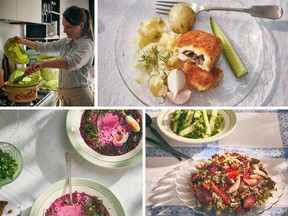
Article content
Reviews and recommendations are unbiased and products are independently selected. Postmedia may earn an affiliate commission from purchases made through links on this page.
Our cookbook of the week is Sour Cherries and Sunflowers by Sydney, Australia-based cook, author and former MasterChef contestant Anastasia Zolotarev.
Jump to the recipes: cold beet borsch, barley pilaf with plums and walnut pesto, and stuffed chicken rissoles.
The taste of sour cherries and the scent of sunflower oil take Anastasia Zolotarev back to her roots. The cook and author was born in Belarus and lived in Ukraine before her family moved to Australia when she was six. Sour Cherries and Sunflowers (Quadrille, 2025) felt right as the title of her cookbook debut. “Sunflowers connect me instantly with Ukraine, and sour cherries do the same, but with Belarus,” says Zolotarev from her home in Sydney.
Sour Cherries and Sunflowers’ more than 80 recipes highlight the seasonality and togetherness at the heart of Eastern European cuisines. From vibrant salads, such as a Belarusian barley pilaf with plums and walnut pesto, and refreshing kholodnyk (cold beet borsch) to pickles and ferments and varenyky (dumplings) that “were made for cooking with others,” Zolotarev showcases the different ways Eastern Europeans prepare and celebrate food. “I wanted to give people a taste of my home and also communicate how we cook these recipes.”
After graduating from the University of Technology Sydney with a tourism management and marketing degree, Zolotarev worked in events and hospitality. She was drawn to the creative side of the business and, having grown up in a food-focused family with a passion for home cooking, started to immerse herself. When she applied for MasterChef Australia, “it all kind of erupted from there.”
Zolotarev was a contestant in Season 8 of the reality show, which aired in 2016. People immediately began asking her if she planned to write a cookbook. “I felt, ‘Why would I write a cookbook? I’ve got nothing to write about. I’m just starting out. I’m just learning.'” She started doing work experience in restaurants and continued honing her skills. But those questions planted a seed. Zolotarev took on more food styling and content creation work in the hopes of figuring out her next steps. Then, on a trip back to Ukraine, her future snapped into focus.
“I was in Kyiv, and I was just hit with this incredible, intense sensation of, ‘Oh my gosh, the food culture here is absolutely incredible.’ And it was funny because I, of course, had travelled back over the years before that, but I wasn’t in that mindset. I guess it was normal for me. It was like an everyday thing. I was brought up with the food. I would travel back and forth, and it was just around me. But after MasterChef, it was a really eye-opening experience.”
In the TV studio, she had learned about many other food cultures. Travelling with her mother, Elena, in 2017, Zolotarev saw the cuisines of her heritage in a new light. She knew she had a story to tell.
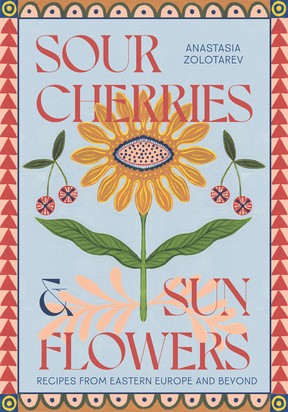
Zolotarev was born in Baranavichy, western Belarus, to a Ukrainian dad and a Belarusian mom. In 1994, her family left her father’s home in Kharkiv, Ukraine, after living with her paternal grandparents for five years. Whenever she returns, she typically visits both countries.
“I remember being on the bus (from Ukraine to Belarus), and it was this really intense feeling and sensation. And I just felt like, ‘I have to share more about this food culture,’ whatever that might mean at that point. I didn’t really know exactly. And then I also kind of felt like, ‘OK, I want to write a book. Maybe I do have something to write about.'”
Zolotarev spent several years laying the groundwork for Sour Cherries and Sunflowers, talking with family, including her babushka Liana, who left Ukraine to join them in Sydney, and her late babushka Lida in Baranavichy. It was a valuable learning period. Though Zolotarev had grown up steeped in the food culture, she didn’t know its intricacies.
“It all came with this incredible deep knowledge and understanding and a connection for food and culture and so much meaning,” says Zolotarev. “It was a very step-by-step, slow, intuitive process. So, every year, there was sort of a different stage and chapter, and I went back and forth trying to understand how to bring this book together. Because it was all new to me, and on the side, I was also working in food. It was all just very new territory, new waters that I was trying to get through and understand.”
She discovered the hows and whys of the dishes and learned more about her own history through interviews with family, friends and other members of the community. Zolotarev says that interviewing her family was especially rewarding. As they recounted stories, past experiences and people dear to them came to life.
As with the Russian invasion of Ukraine, circumstances can change quickly. “So, it’s up to us people to capture (traditions) in some way or another, whether it’s writing, recording, documenting visually or somehow. Those things are important for our identity and our connection. And I think one of the things is when people do move away, far from their original home because of conflict, there’s this trauma that’s either hidden away and locked up, or it’s alive and continues. And every family deals with it differently, of course, but it’s there, and I think it’s important to express it or process it in some way or another.”
Spending time with talented cooks in Belarus, Ukraine and the diaspora made her realize how much she still had to learn. “(The) research for the book has been one of the most special processes for me. I was just thinking last week how it’s actually kind of sad that it’s over,” says Zolotarev, laughing. “The journey meant so much to me, and I’m going to treasure it.”
COLD BEET BORSCH
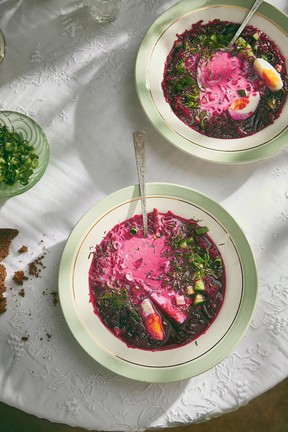
Kholodnyk
Serves: 4
5 medium-large beets (stems and leaves removed, but keep the skin and the natural ends for flavour and colour), washed well
1 tsp apple cider vinegar
4 eggs
2 cucumbers
Small bunch of dill
A few stems of spring onions (scallions)
Lemon wedges, for squeezing
Sour cream, to serve
Step 1
Put the beets in a large saucepan and cover with enough water to cover the beets and fill the pan three-quarters full, about 2.5 litres. Add the vinegar, cover with a lid and bring to the boil, then reduce the heat and simmer for 1 hour or until the beets are cooked through. (Check by piercing one with a fork or skewer: it should easily pass through to the centre.)
Step 2
Transfer the cooked beets to a bowl, reserving the liquid, as this will be the base of the soup. Cool the liquid to room temperature, then transfer the liquid and bowl of beets to the refrigerator for a couple of hours until cold.
Step 3
Meanwhile, place the eggs in a small saucepan of cold water. Bring to the boil and cook for 9 minutes, then plunge into cold water to stop the cooking. Peel and slice into halves or quarters.
Step 4
When you are ready to serve, prepare the rest of the ingredients: dice the cucumbers, finely chop the dill, and slice the spring onions. Peel and grate the chilled beets.
Step 5
Divide everything between serving bowls and serve with a squeeze of lemon, a dollop of sour cream and some fresh bread, if you like.
BARLEY PILAF WITH PLUMS AND WALNUT PESTO
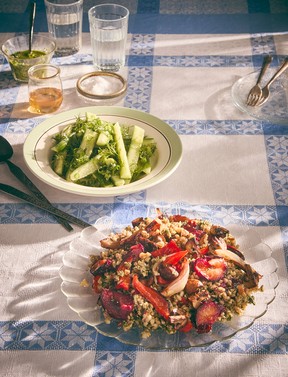
Piarlouki sa slivami i hreckimi arechami
Serves: 4 as a side
200 g (7 oz) pearl barley, rinsed
200 g (7 oz) chestnut (Swiss) mushrooms or other seasonal ones, cleaned then halved or quartered
4 plums, halved and pitted
1 red (bell) pepper, deseeded and cut into wedges
2 onions or shallots, quartered
30 g (1 oz) butter, melted
Salt and pepper
For the pesto:
50 g (1 3/4 oz) walnuts
1/2 bunch of parsley
1/2 bunch of dill
1/2 bunch of basil
1 garlic clove
Generous drizzle of golden unrefined sunflower oil
Step 1
Put the pearl barley in a saucepan with 750 mL (3 cups) water. Add a pinch of salt and bring to the boil. Cover with a lid and lower the heat to simmer for 25-30 minutes, stirring occasionally, or until all the water has been absorbed. You may need to add more water. Once cooked, transfer to a large bowl and leave to cool, stirring occasionally.
Step 2
Preheat the oven to 180C convection (200C/400F). Spread the mushrooms, plums and the vegetables over a baking tray, drizzle with the butter and season with salt and pepper. Roast for 30 minutes.
Step 3
To make the pesto, soak the walnuts in a small bowl of water for 15 minutes. Drain, then add to a blender with the herbs, garlic and oil. Blend and season with salt to taste.
Step 4
Stir a spoonful of the pesto through the pearl barley, then toss through the roasted mushrooms, plums and veg, along with any juices in the tray. Serve warm or cool with extra pesto on the side.
STUFFED CHICKEN RISSOLES
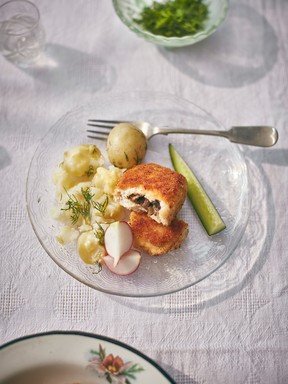
Farshirovannyye kotleti
Serves: 4-6 (makes about 12)
2 small onions, very finely chopped
1 kg (2 lb 4 oz) ground chicken
100 g (3 1/2 oz) butter or sunflower oil for cooking, plus extra butter for the filling
550 g (1 lb 4 oz) mushrooms, very finely diced
1 garlic clove, finely chopped
150 g (5 1/2 oz) breadcrumbs
1 kg (2 lb 4 oz) potatoes, washed, unpeeled
1/2 bunch of fresh dill, fronds chopped
Salt and pepper
Radishes, to serve
Step 1
Set aside half the chopped onion. Transfer the other half to a bowl with the chicken, season well with salt and pepper and mix thoroughly.
Step 2
Heat a large frying pan over a high heat and add 40 g (1 1/2 oz) of the butter or oil along with the mushrooms and stir them through. The mushrooms will quickly absorb the fat. Let the mushrooms cook and release their liquid — this takes about 2 minutes — stirring them occasionally. Then, add the other half of the chopped onions and season with a pinch of salt. Cook, stirring, for a few minutes until the liquid has mostly evaporated. The mixture should smell earthy and aromatic. Stir through the garlic and turn off the heat — you want a bit of ‘rawness’ to the garlic. Transfer the mushrooms to a bowl and set aside until warm but not hot.
Step 3
To make the stuffed chicken rissoles, place the breadcrumbs in a shallow bowl. Wet your hands and take around 90 g (3 1/2 oz) of the raw chicken mixture. I recommend weighing the first amount so you get a good idea of the approximate amount you need. Flatten it in the palm of your hand to an oval shape about 1-cm (1/2-in) thick. Place 2 heaped teaspoons of the cooled mushroom mixture in the centre, then a small knob of butter (about a third of a teaspoon) on top. Bring the outside edges together, encasing the mushroom filling and covering any holes with extra ground chicken. Reshape your rissole into an oval and place in the bowl of breadcrumbs, coating on all sides. Set aside on a board and make the rest.
Step 4
Heat a large pan over a medium-high heat and add a generous amount of butter (about 20 g/3/4 oz) or about a tablespoon of oil. Once hot, add a few rissoles to the pan without overcrowding them. Cook for about 3 1/2 minutes on each side or until the surfaces are golden and crispy, adjusting the heat as needed. Set aside the cooked rissoles and keep warm while you cook the next batch, adding more butter or oil to the pan between batches.
Step 5
Meanwhile, put the potatoes in a medium-large pan and cover with water. Add a generous seasoning of salt. Cover with a lid and bring to a simmer. Move the lid slightly to the edge and simmer the potatoes for about 15 minutes. The time depends on the type and size of your potatoes, but I recommend checking the centre of one after about 15 minutes by piercing it with a fork. Once cooked, drain and transfer the potatoes to a serving bowl and add generous amounts of butter, salt and dill.
Step 6
Serve the rissoles with the potatoes and radishes or other fresh vegetables of your liking.
Recipes and images excerpted from Sour Cherries and Sunflowers: Recipes from Eastern Europe and Beyond by Anastasia Zolotarev. Photography by Karen Fisher and Anastasia Zolotarev.
Our website is the place for the latest breaking news, exclusive scoops, longreads and provocative commentary. Please bookmark nationalpost.com and sign up for our cookbook and recipe newsletter, Cook This, here.














Postmedia is committed to maintaining a lively but civil forum for discussion. Please keep comments relevant and respectful. Comments may take up to an hour to appear on the site. You will receive an email if there is a reply to your comment, an update to a thread you follow or if a user you follow comments. Visit our Community Guidelines for more information.